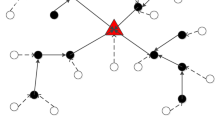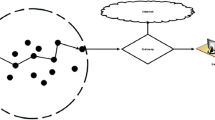Abstract
In wireless sensor network (WSN) redundant data gathering and transmission occurs due to dense deployment. Recently compressive sensing (CS) has attracted considerable attention for efficient data gathering in WSN. CS can reduce data transmission but the total number of transmissions for data collection is high. To alleviate this, hybrid of CS and raw data collection is proposed and integrated with clustering. Clusters used in this integration reduce the number of CS transmissions, but do not reduce the number of transmissions. In a cluster amount of transmission depends on the number of transmitting nodes and their location in data gathering, hence the way in which nodes are clustered together can significantly effect on the number of transmissions in cluster and overall transmissions in network. When density of sensor nodes in a network is high, we can take advantage of their inherent spatial correlation to reduce the number of transmissions. Motivated by this, we propose a novel base station (BS) assisted cluster, spatially correlated, to reduce the number of transmission in a CS-based clustered WSN. Different from other spatially correlated clusters, in this cluster only CH senses, gathers data in the correlated region, and then transmits compressively sensed measurements to BS without incurring any intra-cluster communication cost. In addition, the clusters so formed, convert a randomly deployed network into a structured one i.e. when several clusters are grouped together they form a hexagonal topology (proved to have a high success rate in cellular network). The proposed system makes WSN transmission efficient by reducing number of transmissions in the network and number of data transmission at the CH using clustering and CS. Also energy consumption is reduced and network lifetime is prolonged.












Similar content being viewed by others
References
Akyildiz, I. F., Su, W., Sankarasubramaniam, Y., & Cayirci, E. (2002). Wireless sensor networks: A survey. Communications of the ACM, 38(4), 393–422.
Dabirmoghaddam, A., Ghaderi, M., & Williamson, C. (2010). Cluster-based correlated data gathering in wireless sensor networks. In 2010 IEEE international symposium on modeling, analysis and simulation of computer and telecommunication systems (MASCOTS). IEEE.
Rooshenas, A., Rabiee, H. R., Movaghar, A., & Naderi, M. Y. (2010, December). Reducing the data transmission in wireless sensor networks using the principal component analysis. In 2010 Sixth international conference on intelligent sensors, sensor networks and information processing (ISSNIP) (pp. 133–138). IEEE.
Gastpar, M., Dragotti, P. L., & Vetterli, M. (2006). The distributed karhunen–loeve Transform. IEEE Transactions on Information Theory, 52(12), 5177–5196.
Candès, E. J., & Wakin, M. B. (2008). An introduction to compressive sampling. IEEE Signal Processing Magazine, 25, 21.
Lin, H., Wang, L., & Kong, R. (2015). Energy efficient clustering protocol for large-scale sensor networks. IEEE Sensors Journal, 15(12), 7150–7160.
Xie, R., & Jia, X. (2014). Transmission-efficient clustering method for wireless sensor networks using compressive sensing. IEEE Transactions on Parallel and Distributed Systems, 25(3), 806–815.
Duarte, M. F., Shen, G., Ortega, A., & Baraniuk, R. G. (2012). Signal compression in wireless sensor networks. Philosophical Transactions of the Royal Society A: Mathematical, Physical and Engineering Sciences, 370(1958), 118–135.
Donoho, D. L. (2006). Compressed sensing. IEEE Transactions on Information Theory, 52(4), 1289–1306.
Luo, C., Wu, F., Sun, J., & Chen, C. W. (2009, September). Compressive data gathering for large-scale wireless sensor networks. In Proceedings of the 15th annual international conference on mobile computing and networking (pp. 145–156). ACM.
Luo, J., Xiang, L. & Rosenberg, C. (2010). Does compressed sensing improve the throughput of wireless sensor networks? In 2010 IEEE international conference on communications (ICC). IEEE.
L. Xiang, J. Luo, & Vasilakos, A. (2011, June). Compressed data aggregation for energy efficient wireless sensor networks. In Proceedings of the IEEE sensor, mesh and ad hoc communications and networks (SECON’11) (pp. 46–54).
Nguyen, M. T., & Teague, K. A. (2014). Compressive sensing based data gathering in clustered wireless sensor networks. In 2014 IEEE international conference on distributed computing in sensor systems (DCOSS). IEEE.
Liu, D., Zhou, Q., Zhang, Z., & Liu, B. (2016). Cluster-based energy-efficient transmission using a new hybrid compressed sensing in WSN. In 2016 IEEE conference on computer communications workshops (INFOCOM WKSHPS) (pp. 372–376).
Lan, K.-C., & Wei, M.-Z. (2017). A compressibility-based clustering algorithm for hierarchical compressive data gathering. IEEE Sensors Journal, 17(8), 2550–2562.
Lee, S., Pattem, S., Sathiamoorthy, M., Krishnamachari, B., & Ortega, A. (2009, July). Spatially-localized compressed sensing and routing in multi-hop sensor networks. In International conference on geosensor networks (pp. 11–20). Springer, Berlin.
Xiaoronga, C., Mingxuan, L., & Suc, L. (2012). Study on clustering of wireless sensor network in distribution network monitoring system. Physics Procedia, 25, 1689–1695.
Vuran, M. C., & Akyildiz, I. F. (2006). Spatial correlation-based collaborative medium access control in wireless sensor networks. IEEE/ACM Transactions on Networking, 14(2), 316–329.
Deng, X., Zhong, W., Ren, J., Zeng, D., & Zhang, H. (2016). An imbalanced data classification method based on automatic clustering under-sampling. In 2016 IEEE 35th international performance computing and communications conference (IPCCC) (pp. 1–8). IEEE.
Yuan, J., & Chen, H. (2009, Sep). The optimized clustering technique based on spatial-correlation in wireless sensor networks. In Proceedings of the IEEE youth conference Information, telecommunication and computing YC-ICT (pp. 411–414).
Liu, C., Wu, K., & Pei, J. (2007). An energy-efficient data collection framework for wireless sensor networks by exploiting spatiotemporal correlation. IEEE Transactions on Parallel and Distributed Systems, 18(7), 1010.
Shakya, R. K., Singh, Y. N., & Verma, N. K. (2013). Generic correlation model for wireless sensor network applications. IET Wireless Sensor Systems, 3(4), 266–276.
Liu, Z., Xing, W., Zeng, B., Wang, Y., & Lu, D. (2013, March). Distributed spatial correlation-based clustering for approximate data collection in WSNs. In 2013 IEEE 27th international conference on advanced information networking and applications (AINA) (pp. 56–63). IEEE.
Ramesh, K., & Somasundaram, K. (2012). A comparative study of clusterhead selection algorithms in wireless sensor networks. arXiv preprint arXiv:1205.1673.
Vuran, M. C., Akan, Ö. B., & Akyildiz, I. F. (2004). Spatio-temporal correlation: theory and applications for wireless sensor networks. Computer Networks, 45(3), 245–259.
Zhang, H., & Hou, J. C. (2005). Maintaining sensing coverage and connectivity in large sensor networks. Ad Hoc and Sensor Wireless Networks, 1(1-2), 89–124.
Papastergiou, S., Polemi, D., & Douligeris, C. (2009). SWEB: An advanced mobile residence certificate service. In International conference on e-democracy (pp. 421–430). Springer, Berlin.
Wang, B. (2010). Coverage control in sensor networks. Computer communications and networks. Berlin: Springer. https://doi.org/10.1007/978-1-84996-059-5_2.
Liaqat, M., et al. (2014). HEX clustering protocol for routing in wireless sensor network. In 2014 IEEE 28th international conference on advanced information networking and applications (AINA). IEEE.
Ouni, S., & Ayoub, Z. T. (2013). Predicting communication delay and energy consumption for IEEE 802.15.4/Zigbee wireless sensor networks. International Journal of Computer Networks Communications, 5(1), 141.
Heinzelman, W. B. (2000). Application-specific protocol architectures for wireless networks. Diss. Massachusetts Institute of Technology.
Yuan, F., Zhan, Y., & Wang, Y. (2014). Data density correlation degree clustering method for data aggregation in WSN. IEEE Sensors Journal, 14(4), 1089–1098.
Razzaque, M. A., & Dobson, S. (2014). Energy-efficient sensing in wireless sensor networks using compressed sensing. Sensors, 14(2), 2822–2859.
Zhu, L., Ci, B., Liu, Y., & Chen, Z. (2015). Data gathering in wireless sensor networks based on reshuffling cluster compressed sensing. International Journal of Distributed Sensor Networks, 11(11), 260913.
Intel Labs Berkeley Data. http://db.csul.mit.edu/www.select.cs.cmu.edu/data/labapp3/.
Quer, G., Masiero, R., Pillonetto, G., Rossi, M., & Zorzi, M. (2012). Sensing, compression, and recovery for WSNS: Sparse signal modeling and monitoring framework. IEEE Transactions on Wireless Communications, 11(10), 3447–3461.
Author information
Authors and Affiliations
Corresponding author
Additional information
Publisher's Note
Springer Nature remains neutral with regard to jurisdictional claims in published maps and institutional affiliations.
Appendix
Appendix
Consider triangle ABC with inscribed circle of radius OM = \(r_{s}\) (Fig. 13).
In the right angle triangle ANM,
Considering, \(\Delta AOB\), BC is tangent to the circle at O. Therefore \(\Delta AOB\) is a right angled triangle at O and \(\angle BAO\) = \(30^\circ\)
Since ∠A + ∠B + ∠O = \(180^\circ\)
Therefore ∠B = \(60^\circ\)
Similarly ∠C = \(60^\circ\) and ∠A = \(60^\circ\)
Since ∠A = ∠B = ∠C = \(60^\circ\)
Thus, the triangle is an equilateral triangle.
Rights and permissions
About this article
Cite this article
Pacharaney, U.S., Gupta, R.K. Clustering and Compressive Data Gathering in Wireless Sensor Network. Wireless Pers Commun 109, 1311–1331 (2019). https://doi.org/10.1007/s11277-019-06614-5
Published:
Issue Date:
DOI: https://doi.org/10.1007/s11277-019-06614-5





